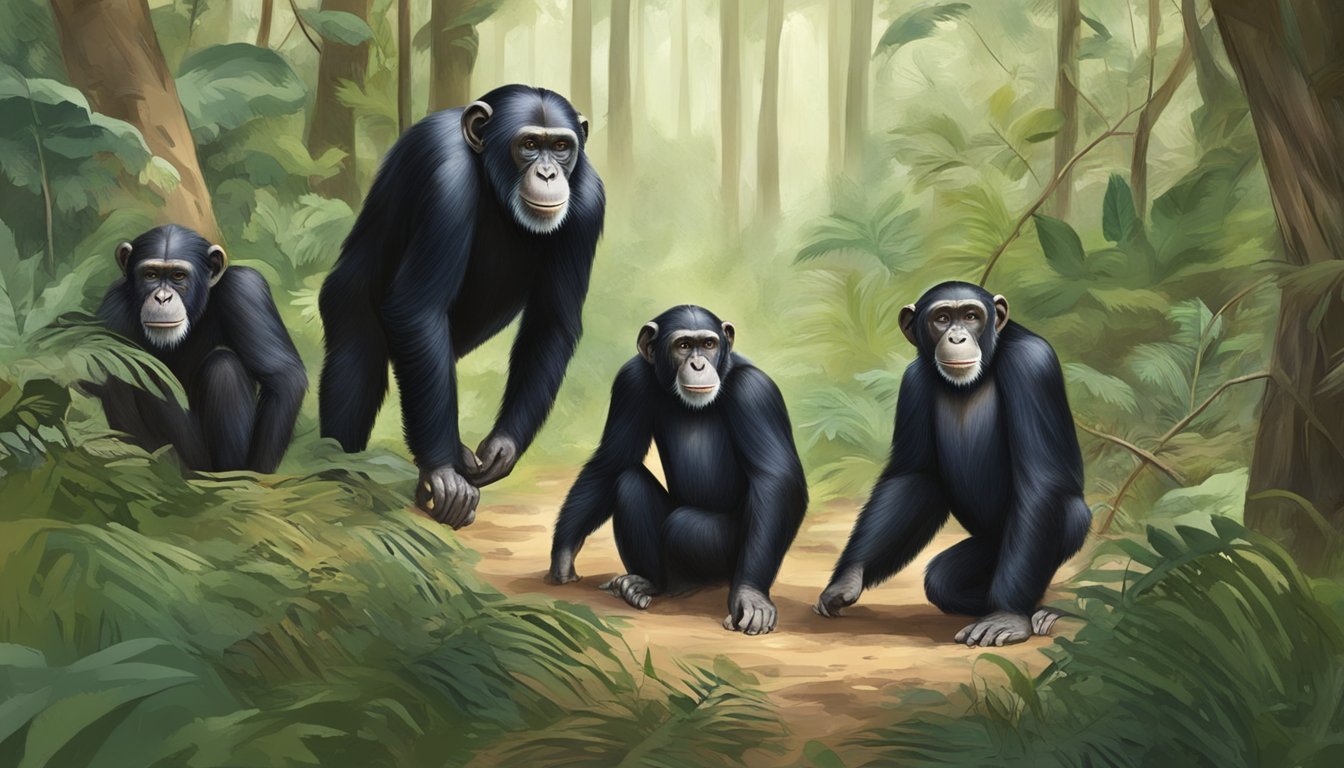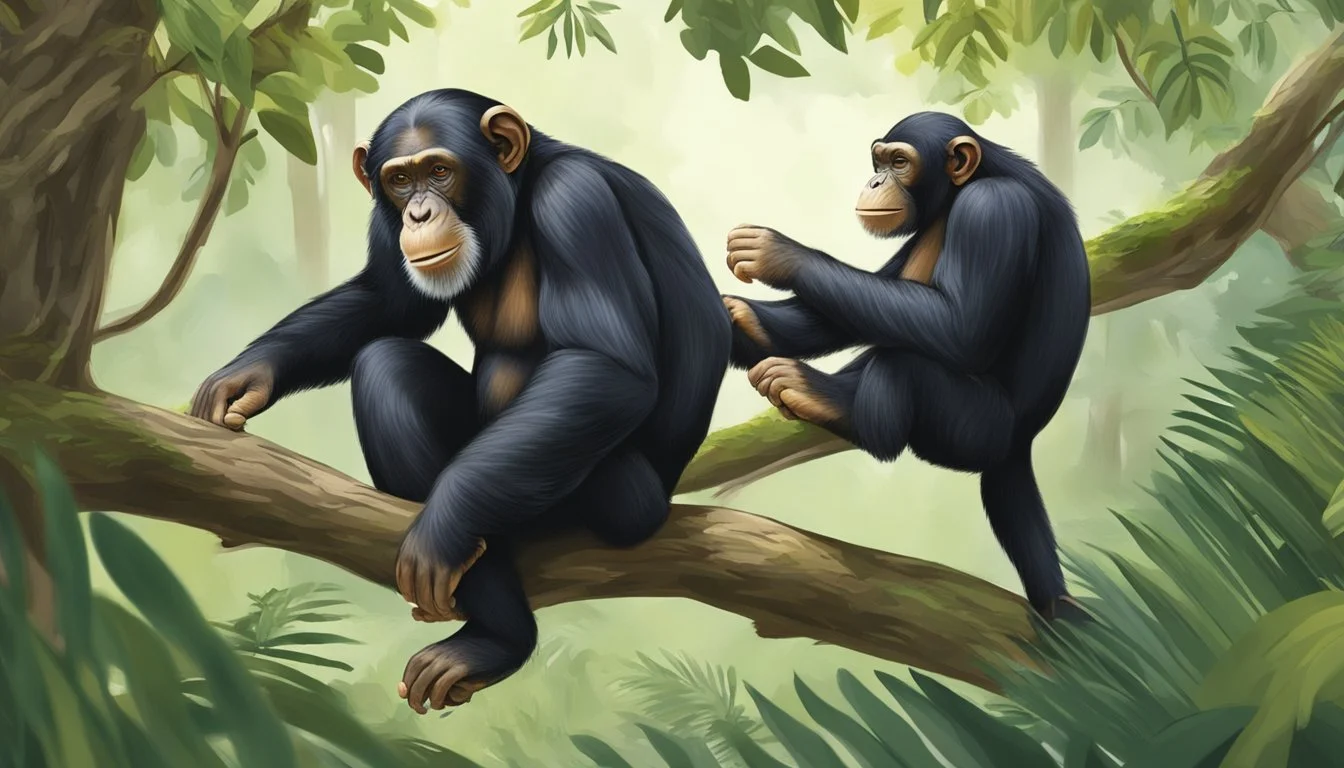Chimp Secrets Exposed: Shocking Revelations of Primate Power Struggles!
Chimpanzees captivate audiences with their intelligence, complex social structures, and striking similarities to humans. Documentaries about these remarkable primates offer viewers an intimate glimpse into their world, showcasing their behaviors, relationships, and the challenges they face in both wild and captive environments.
Several compelling documentaries have shed light on chimpanzee communities, including "The Society of Chimpanzees" and "Chimp Empire." These films employ cutting-edge filming techniques to capture never-before-seen footage of chimpanzees in their natural habitats. Viewers witness intricate social dynamics, family bonds, and territorial disputes unfold in stunning detail.
Recent documentaries like "Chimp Crazy" also explore the controversial topic of chimpanzees kept as pets or in captivity. These thought-provoking films raise important questions about the ethical treatment of our closest animal relatives and the complex relationship between humans and chimpanzees.
The Life of Chimpanzees
Chimpanzees lead complex and fascinating lives characterized by intricate social structures, diverse habitats, and remarkable behaviors. These great apes face significant conservation challenges in the modern world.
Social Structure and Dynamics
Chimpanzees live in complex social groups called communities, typically consisting of 20 to 150 individuals. These communities are hierarchical, with dominant males at the top. Females often leave their natal groups upon reaching maturity, while males usually remain.
Social bonds are reinforced through grooming. This activity serves both hygienic and social purposes, helping to build and maintain relationships within the group. Chimpanzees also engage in coalition-forming, where individuals team up to gain status or access to resources.
Mothers and infants share a strong bond. Young chimps stay with their mothers for several years, learning essential survival and social skills. This extended period of dependency is crucial for their development and integration into the community.
Habitats and Distribution
Chimpanzees are found in a variety of habitats across central and western Africa. They primarily inhabit tropical rainforests but can also be found in woodlands, grasslands, and mountainous regions.
Their range extends from Senegal in the west to Tanzania in the east. Key countries with significant chimpanzee populations include Uganda, the Democratic Republic of Congo, and Côte d'Ivoire.
Chimpanzees are adaptable and can thrive in diverse environments. They build nests in trees for sleeping and rest, constructing new ones almost daily. These nests provide safety from predators and comfortable sleeping arrangements.
Chimpanzee Behavior
Chimpanzees display a wide range of behaviors that showcase their intelligence and adaptability. They are known for their tool use, a trait once thought to be uniquely human. Chimps fashion tools from sticks and leaves to "fish" for termites or crack open nuts.
Communication among chimpanzees is sophisticated, involving vocalizations, facial expressions, and body language. They use a variety of calls, including pant-hoots for long-distance communication and screams to signal distress or excitement.
Hunting is another notable behavior. While primarily frugivorous, chimpanzees occasionally hunt small mammals, particularly colobus monkeys. This activity often involves coordinated group efforts, demonstrating their capacity for teamwork.
Conservation Status
Chimpanzees face numerous threats in the wild, leading to their classification as endangered. Habitat loss due to deforestation and agricultural expansion is a primary concern. Human activities such as logging and mining further fragment their habitats.
Poaching for bushmeat and the illegal pet trade also pose significant risks. Disease transmission from humans, including respiratory infections, has become an increasing threat, particularly in areas where ecotourism is prevalent.
Conservation efforts focus on habitat protection, anti-poaching measures, and community education. Sanctuaries and rehabilitation centers play a crucial role in caring for orphaned or rescued chimpanzees. Research into chimpanzee behavior and ecology continues to inform conservation strategies, helping to secure a future for these remarkable primates.
Evolution and Species Classification
Chimpanzees belong to the great ape family and share a close evolutionary relationship with humans. Their classification and distinguishing traits provide insights into primate evolution and our shared ancestry.
Chimp Family Tree
Chimpanzees are part of the genus Pan, which includes two species: Pan troglodytes (common chimpanzee) and Pan paniscus (bonobo). These species diverged from the human lineage approximately 5-7 million years ago. Chimpanzees and bonobos are our closest living relatives, sharing about 98% of our DNA.
The great ape family, Hominidae, includes chimpanzees, gorillas, orangutans, and humans. This classification reflects our shared evolutionary history and common anatomical features. Fossil evidence, such as Ardipithecus ramidus, suggests that early human ancestors may have walked differently from both modern humans and chimpanzees.
Distinguishing Features
Chimpanzees possess several unique characteristics that set them apart from other primates. They have opposable thumbs and big toes, enabling precise manipulation of objects. Their arms are longer than their legs, adapted for both terrestrial and arboreal locomotion.
Chimpanzees exhibit high cognitive abilities, using tools and displaying complex social behaviors. They have a larger brain-to-body size ratio compared to other non-human primates. Their facial features include a pronounced brow ridge, small nose, and protruding lips.
Genetic studies have revealed that chimpanzees have 24 chromosome pairs, while humans have 23. This difference is due to a fusion of two ancestral chromosomes in the human lineage after the split from our common ancestor with chimpanzees.
Documentary Filmmaking in Nature
Nature documentaries bring the wild world to viewers through skilled storytelling and technical prowess. These films face unique challenges and ethical considerations while capturing animal behavior in remote environments.
Storytelling in Wildlife Documentaries
Wildlife documentaries weave compelling narratives around animal subjects. Filmmakers carefully select footage to create story arcs that engage audiences. They often focus on individual animals or family groups to build emotional connections.
Narration plays a crucial role in guiding viewers through the action. Celebrity voices like Tim Allen in "Chimpanzee" add star power and accessibility to scientific content.
Dramatic techniques heighten tension and excitement. Slow-motion shots, time-lapse sequences, and carefully edited chase scenes make animal behavior more captivating for viewers.
Technical Challenges
Filming wildlife requires specialized equipment and techniques. Long-range lenses and camouflaged blinds allow crews to capture intimate animal moments without disturbing natural behavior.
Harsh environments pose obstacles. Teams endure extreme weather, difficult terrain, and long hours waiting for the perfect shot.
New technologies expand filming possibilities. Drones provide aerial perspectives, while underwater cameras reveal aquatic ecosystems. High-definition and slow-motion capabilities produce stunning visuals of fast-moving animals.
Ethical Considerations
Nature documentaries must balance entertainment with responsible filmmaking. Crews follow strict guidelines to minimize their impact on wildlife and habitats.
Transparency about filming methods is crucial. Some productions disclose when scenes are staged or when multiple events are edited together.
Conservation messages often feature prominently. Many documentaries use their platform to raise awareness about endangered species and habitats.
Filmmakers face ethical dilemmas when witnessing animal suffering. Most adopt a non-intervention policy, allowing nature to take its course even in difficult situations.
Iconic Documentaries and Series
Chimpanzee documentaries have captivated audiences for decades, offering glimpses into the lives of our closest animal relatives. These films showcase groundbreaking research, conservation efforts, and the complex social dynamics of chimp communities.
Jane Goodall's Contribution
Jane Goodall's pioneering work in Tanzania revolutionized our understanding of chimpanzees. Her 1965 documentary "Miss Goodall and the Wild Chimpanzees" introduced viewers to the chimps of Gombe National Park. This film marked the beginning of Goodall's lifelong commitment to chimpanzee research and conservation.
Goodall's observations challenged prevailing notions about chimp behavior. She documented tool use, hunting, and complex social relationships among the Gombe chimps. Her work sparked public interest in primatology and inspired generations of researchers.
Subsequent documentaries featuring Goodall's work have continued to educate and inspire audiences worldwide. These films often highlight the similarities between humans and chimps, fostering empathy and support for conservation efforts.
Chimp Empire Series
The "Chimp Empire" docuseries offers an in-depth look at chimpanzee society in Uganda's Ngogo forest. Narrated by Academy Award-winner Mahershala Ali, the series explores the politics, alliances, and conflicts within a large chimp community.
Filmed over two years, "Chimp Empire" showcases the complex social dynamics of chimpanzees. The series documents power struggles, territorial disputes, and cooperation among community members. It provides viewers with an unprecedented look at chimp behavior in the wild.
The docuseries combines stunning cinematography with expert commentary to create an engaging and educational experience. It sheds light on the intelligence and emotional complexity of chimpanzees, emphasizing their need for protection.
Notable Documentaries Featuring Chimpanzees
Several other documentaries have made significant contributions to public understanding of chimpanzees. "Chimpanzee" (2012), produced by Disneynature, follows the story of young Oscar in the Taï Forest of Ivory Coast. The film captures the challenges faced by young chimps and the importance of social bonds.
"Project Nim" (2011) explores the ethical implications of animal research through the story of a chimpanzee raised as a human. This thought-provoking documentary raises questions about the boundaries between humans and other primates.
"Meet the Chimps" (2020) offers a unique perspective by focusing on the residents of Chimp Haven, a sanctuary in Louisiana. This series highlights the individual personalities of rescued chimps and the efforts to provide them with a fulfilling life in captivity.
Renowned Habitats and Research Sites
Several locations around the world provide crucial habitats for chimpanzees and serve as important research sites. These areas offer unique opportunities to study chimpanzee behavior, ecology, and conservation in their natural environments.
Gombe Stream National Park
Gombe Stream National Park in Tanzania is renowned for its chimpanzee research. Dr. Jane Goodall began her groundbreaking studies here in 1960. The park covers 52 square kilometers of forest along Lake Tanganyika.
Researchers at Gombe have documented tool use, hunting behaviors, and social structures among chimpanzees. Long-term studies have revealed insights into chimpanzee family dynamics and culture.
Gombe's chimpanzee population faces challenges from habitat loss and disease. Conservation efforts focus on protecting the park's boundaries and working with local communities.
Kibale National Park
Kibale National Park in Uganda is home to diverse primate species, including a significant chimpanzee population. The park spans 795 square kilometers of tropical forest.
Researchers study chimpanzee behavior, ecology, and cognition in Kibale. The Ngogo Chimpanzee Project has observed the largest known chimpanzee community, providing valuable data on social dynamics.
Kibale's protected status helps maintain crucial habitat for chimpanzees. Tourism activities, such as chimpanzee tracking, support conservation efforts and local economies.
Sanctuaries and Rehabilitation Centers
Sanctuaries and rehabilitation centers play a vital role in chimpanzee conservation. These facilities care for rescued and retired chimpanzees, many from research laboratories or the illegal pet trade.
Save the Chimps in Florida is the world's largest chimpanzee sanctuary. It provides lifelong care for over 200 chimpanzees across 12 island habitats.
Chimp Haven in Louisiana serves as the National Chimpanzee Sanctuary. It houses more than 300 chimpanzees retired from medical research, offering them a natural environment to thrive.
These sanctuaries focus on chimpanzee welfare and education. They contribute to public awareness about chimpanzee conservation and the ethical treatment of great apes.
Chimpanzee Intelligence and Learning
Chimpanzees display remarkable cognitive abilities and complex social behaviors that rival those of humans in many ways. Their capacity for learning, problem-solving, and cultural transmission sets them apart as one of the most intelligent non-human species.
Cognitive Abilities
Chimpanzees exhibit impressive memory and problem-solving skills. In controlled experiments, some chimps outperform humans in short-term memory tasks. Ayumu, a chimpanzee at Kyoto University, demonstrated the ability to recall the positions of numbers flashed briefly on a screen with greater speed and accuracy than human participants.
Chimps also show self-awareness, recognizing themselves in mirrors and understanding the concept of "self." They can learn human sign language and use abstract symbols to communicate complex ideas. Researchers have documented chimps using mental maps to navigate their territories and plan future actions.
Tool Use and Culture
Chimpanzees are prolific tool users, crafting and utilizing various implements to access food sources. They fashion fishing rods from twigs to extract termites from mounds and use stones as hammers to crack open nuts. These behaviors vary between chimp communities, indicating cultural transmission of knowledge.
Distinct "cultures" emerge in different chimpanzee groups, with unique tool preferences and social customs passed down through generations. Some populations use leaf sponges to drink water, while others create specialized tools for hunting small mammals.
Chimps break down complex tasks into smaller, manageable steps, much like humans. This ability to sequence actions demonstrates advanced cognitive processing and problem-solving skills.
Human-Chimpanzee Conflict and Coexistence
Chimpanzees and humans face complex challenges as their habitats overlap. Conflicts arise from habitat loss, resource competition, and disease transmission. Conservation efforts aim to protect chimps while addressing human needs.
Habitat Encroachment
Human population growth and agricultural expansion have led to significant habitat loss for chimpanzees. Forests are cleared for farming, logging, and settlements, forcing chimps into smaller areas. This encroachment results in increased encounters between humans and chimpanzees.
Chimps may raid crops or enter villages in search of food, leading to conflicts with local communities. In some cases, these encounters turn violent, with injuries to both humans and chimps. Farmers often view chimpanzees as pests, resorting to retaliatory killings despite legal protections.
Conservation groups work to create buffer zones and corridors to reduce direct contact. They also promote sustainable land-use practices to balance human needs with chimpanzee habitat preservation.
Disease Transmission
Close genetic relation between humans and chimpanzees increases the risk of zoonotic disease transmission. Ebola, HIV, and respiratory illnesses can pass between species. This threat goes both ways - human diseases can devastate chimpanzee populations lacking immunity.
Research teams closely monitor chimp health in protected areas. They implement strict hygiene protocols to minimize disease spread during observation or conservation activities. Vaccination programs for surrounding human populations help reduce transmission risks.
Public health initiatives in chimp-adjacent communities are crucial. These programs improve sanitation, provide healthcare access, and educate locals about disease prevention strategies.
Conservation Efforts
Chimpanzee conservation combines habitat protection, community engagement, and scientific research. Protected areas and national parks play a vital role in preserving chimp populations. Rangers patrol these zones to prevent poaching and illegal logging.
Community-based conservation involves local people in protection efforts. Programs offer alternative livelihoods to reduce dependence on forest resources. Environmental education raises awareness about chimpanzee importance and promotes coexistence.
Rehabilitation centers care for orphaned or injured chimps, aiming to return them to the wild when possible. These facilities also serve as research hubs, advancing our understanding of chimpanzee behavior and needs.
International collaborations support these efforts through funding, expertise sharing, and policy advocacy. Conservation groups work with governments to strengthen legal protections for chimpanzees and their habitats.
Famous Chimpanzees in History
Certain chimpanzees have gained notoriety through their roles in entertainment and scientific research. These individuals have shaped public perception and advanced our understanding of primate intelligence and behavior.
Hollywood's Portrayal of Chimpanzees
Chimpanzees have long captivated audiences on the big screen. One notable chimp actor was Cheetah, who appeared in the Tarzan films of the 1930s and 1940s. Another famous chimp was J. Fred Muggs, who co-hosted NBC's Today Show in the 1950s.
More recently, Tonka starred in several films including "Buddy" and "George of the Jungle." These portrayals, while entertaining, often presented unrealistic depictions of chimpanzee behavior and capabilities.
Hollywood's use of chimpanzees has declined due to ethical concerns and improved computer-generated imagery. Many animal welfare organizations now discourage the use of primates in entertainment.
Chimpanzees in Research
Nim Chimpsky gained fame as the subject of a language acquisition study in the 1970s. Researchers attempted to teach Nim sign language to explore the limits of chimpanzee communication.
Another well-known research subject was Washoe, who learned over 350 signs of American Sign Language. Her abilities challenged previous assumptions about animal cognition and language.
Lucy Temerlin, raised in a human household, demonstrated remarkable human-like behaviors. Her story highlighted both the cognitive abilities of chimpanzees and the ethical complexities of such experiments.
These studies have contributed significantly to our understanding of primate intelligence. However, they've also sparked debates about the ethics of using chimpanzees in research.
Future of Chimpanzees and Conservation
Conservation efforts and international protections are shaping the future for chimpanzees. Sanctuaries and zoos play crucial roles in caring for rescued chimps and educating the public about these remarkable primates.
International Laws and Protections
The Endangered Species Act now protects all chimpanzees, both wild and captive. This landmark decision in 2015 allows for stronger legal tools to improve captive chimp welfare. Several countries have banned the use of great apes in research and entertainment.
The Convention on International Trade in Endangered Species (CITES) restricts the international trade of chimpanzees and their body parts. These protections aim to combat poaching and habitat loss.
Conservation groups like Save the Chimps advocate for stricter laws to prevent private ownership of chimps as pets. They push for legislation to close loopholes that allow exploitation of these intelligent primates.
Role of Zoos and Sanctuaries
Accredited zoos contribute to chimpanzee conservation through breeding programs and public education. Many participate in the Species Survival Plan to maintain genetic diversity in captive populations.
Sanctuaries like Chimp Eden in South Africa provide lifelong care for rescued chimps. These facilities offer large, naturalistic habitats where chimps can form social groups and exhibit natural behaviors.
Zoos and sanctuaries conduct important research on chimpanzee behavior, cognition, and health. This knowledge aids conservation efforts for wild populations.
Public outreach programs at these facilities raise awareness about the threats facing chimpanzees. They inspire visitors to support conservation initiatives and make ethical consumer choices that protect chimp habitats.





